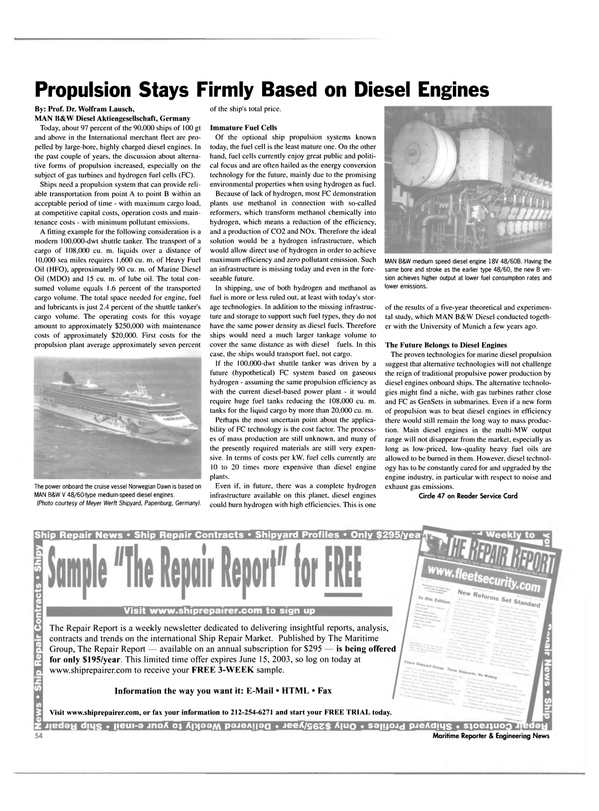
Propulsion Stays Firmly Based on Diesel Engines
MAN 15&W Diesel Aktiengesellschaft, Germany Today, about 97 percent of the 90,000 ships of 100 gt and above in the International merchant fleet are propelled by large-bore, highly charged diesel engines. In the past couple of years, the discussion about alternative forms of propulsion increased, especially on the subject of gas turbines and hydrogen fuel cells (FC).
Ships need a propulsion system that can provide reliable transportation from point A to point B within an acceptable period of time - with maximum cargo load, at competitive capital costs, operation costs and maintenance costs - with minimum pollutant emissions.
A fitting example for the following consideration is a modern 100,000-dwt shuttle tanker. The transport of a cargo of 108,000 cu. m. liquids over a distance of 10,000 sea miles requires 1,600 cu. m. of Heavy Fuel Oil (HFO), approximately 90 cu. m. of Marine Diesel Oil (MDO) and 15 cu. m. of lube oil. The total consumed volume equals 1.6 percent of the transported cargo volume. The total space needed for engine, fuel and lubricants is just 2.4 percent of the shuttle tanker's cargo volume. The operating costs for this voyage amount to approximately $250,000 with maintenance costs of approximately $20,000. First costs for the propulsion plant average approximately seven percent of the ship's total price.
Immature Fuel Cells Of the optional ship propulsion systems known today, the fuel cell is the least mature one. On the other hand, fuel cells currently enjoy great public and political focus and are often hailed as the energy conversion technology for the future, mainly due to the promising environmental properties when using hydrogen as fuel.
Because of lack of hydrogen, most FC demonstration plants use methanol in connection with so-called reformers, which transform methanol chemically into hydrogen, which means a reduction of the efficiency, and a production of C 0 2 and NOx. Therefore the ideal solution would be a hydrogen infrastructure, which would allow direct use of hydrogen in order to achieve maximum efficiency and zero pollutant emission. Such an infrastructure is missing today and even in the foreseeable future.
In shipping, use of both hydrogen and methanol as fuel is more or less ruled out, at least with today's storage technologies. In addition to the missing infrastructure and storage to support such fuel types, they do not have the same power density as diesel fuels. Therefore ships would need a much larger tankage volume to cover the same distance as with diesel fuels. In this case, the ships would transport fuel, not cargo.
If the 100,000-dwt shuttle tanker was driven by a future (hypothetical) FC system based on gaseous hydrogen - assuming the same propulsion efficiency as with the current diesel-based power plant - it would require huge fuel tanks reducing the 108,000 cu. m.
tanks for the liquid cargo by more than 20,000 cu. m.
Perhaps the most uncertain point about the applicability of FC technology is the cost factor. The processes of mass production are still unknown, and many of the presently required materials are still very expensive.
In terms of costs per kW. fuel cells currently are 10 to 20 times more expensive than diesel engine plants.
Even if, in future, there was a complete hydrogen infrastructure available on this planet, diesel engines could burn hydrogen with high efficiencies. This is one of the results of a five-year theoretical and experimental study, which MAN B&W Diesel conducted together with the University of Munich a few years ago.
The Future Belongs to Diesel Engines The proven technologies for marine diesel propulsion suggest that alternative technologies will not challenge the reign of traditional propulsive power production by diesel engines onboard ships. The alternative technologies might find a niche, with gas turbines rather close and FC as GenSets in submarines. Even if a new form of propulsion was to beat diesel engines in efficiency there would still remain the long way to mass production.
Main diesel engines in the multi-MW output range will not disappear from the market, especially as long as low-priced, low-quality heavy fuel oils are allowed to be burned in them. However, diesel technology has to be constantly cared for and upgraded by the engine industry, in particular with respect to noise and exhaust gas emissions.
Circle 47 on Reader Service Card
Read Propulsion Stays Firmly Based on Diesel Engines in Pdf, Flash or Html5 edition of May 2003 Maritime Reporter
Other stories from May 2003 issue
Content
- NASSCO Delivers First of ORCA Class page: 10
- Aerodynamic Garage Ships page: 12
- RoPax Milestone page: 14
- Safe Boats Wins 700- Boat, $145-M Contract page: 17
- "I'm Looking Through You" page: 18
- Damen Offers Disaster Prevention Vessels page: 22
- NCL Acquires S/S United States page: 23
- Farstad Shipping Goes Big page: 24
- Frontline Continues to Blaze a Path page: 24
- Solid Roots to Withstand Future Storms page: 25
- The Best of Both Worlds page: 26
- MP: Eying Patrol Potential page: 30
- DNV Maritime: Changing of the Guard page: 31
- Small Tankers, Huge Market Potential page: 33
- Knutsen OAS Shipping Leads Gas Shipping Charge page: 34
- Nor-Shipping 2003: Bigger Than Ever page: 37
- Tribon M2 Enhanced Again page: 39
- Optimized Data Communication at Bergesen page: 39
- SES Electrical Sees Bright Future page: 39
- An Innovative LNG Carrier Concept page: 40
- A Multi-Billion Opportunity page: 40
- The Wartsila Dual-Fuel Engine page: 41
- Aluminum Gone "Bad" page: 42
- Integration Of AIS And ECDIS: More Information, Better View, Improved Safety page: 46
- Robert Allan: Naval Architecture is in the Blood page: 50
- Custom Solutions page: 52
- The Big One: L.A. Fireboat 2 page: 53
- Propulsion Stays Firmly Based on Diesel Engines page: 54
- Bunker Industry Fueled by Word Affairs page: 56
- Lube Oils on Test page: 57
- EMMIF: Getting Heavy With Bunkers page: 58
- Onboard-Napa Power Yields Fuel Savings page: 58
- Algae-X — Optimal Fuel and Oil Quality page: 61


